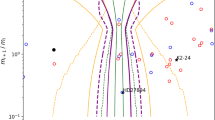Abstract
As a result of resonance overlap, planetary systems can exhibit chaotic motion. Planetary chaos has been studied extensively in the Hamiltonian framework, however, the presence of chaotic motion in systems where dissipative effects are important, has not been thoroughly investigated. Here, we study the onset of stochastic motion in presence of dissipation, in the context of classical perturbation theory, and show that planetary systems approach chaos via a period-doubling route as dissipation is gradually reduced. Furthermore, we demonstrate that chaotic strange attractors can exist in mildly damped systems. The results presented here are of interest for understanding the early dynamical evolution of chaotic planetary systems, as they may have transitioned to chaos from a quasi-periodic state, dominated by dissipative interactions with the birth nebula.
Similar content being viewed by others
References
Albers D.J., Sprott J.C.: Routes to chaos in high-dimensional dynamical systems: a qualitative numerical study. Phys. D Nonlinear Phenom. 223, 194–207 (2006)
Batygin K., Bodenheimer P., Laughlin G.: Determination of the interior structure of transiting planets in multiple-planet systems. Astrophys. J. 704, L49–L53 (2009)
Batygin K., Laughlin G.: On the dynamical stability of the solar system. Astrophys. J. 683, 1207–1216 (2008)
Batygin K., Laughlin G., Meschiari S., Rivera E., Vogt S., Butler P.: A quasi-stationary solution to Gliese 436b’s eccentricity. Astrophys. J. 699, 23–30 (2009)
Batygin K., Laughlin G.: Resolving the sin(I) degeneracy in low-mass multi-planet systems. Astrophys. J. 730, 95 (2011)
Beauge C., Ferraz-Mello S.: Resonance trapping in the primordial solar nebula—the case of a Stokes drag dissipation. Icarus 103, 301–318 (1993)
Benettin G., Galgani L., Strelcyn J.-M.: Kolmogorov entropy and numerical experiments. Phys. Rev. A 14, 2338–2345 (1976)
Bruhwiler D.L., Cary J.R.: Diffusion of particles in a slowly modulated wave. Phys. D Nonlinear Phenom. 40, 265–282 (1989)
Chirikov B.V.: A universal instability of many-dimensional oscillator systems. Phys. Rep. 52, 263–379 (1979)
Goldreich, P., Soter, S.: Q in the solar system. Icarus 5, 375–389 (1966)
Gonczi R., Froeschle C., Froeschle C.: Poynting–Robertson drag and orbital resonance. Icarus 51, 633–654 (1982)
Henrard J., Henrard M.: Slow crossing of a stochastic layer. Phys. D Nonlinear Phenom. 54, 135–146 (1991)
Henrard J., Lemaitre A.: A second fundamental model for resonance. Celest. Mech. 30, 197–218 (1983)
Henrard J., Morbidelli A.: Slow crossing of a stochastic layer. Phys. D Nonlinear Phenom. 68, 187–200 (1993)
Laskar J.: A numerical experiment on the chaotic behaviour of the solar system. Nature 338, 237 (1989)
Laskar J.: Large-scale chaos in the solar system. Astron. Astrophys. 287, L9–L12 (1994)
Laskar J.: Large scale chaos and marginal stability in the solar system. Celest. Mech. Dyn. Astron. 64, 115–162 (1996)
Laskar J., Gastineau M.: Existence of collisional trajectories of mercury, mars and venus with the earth. Nature 459, 817–819 (2009)
Lee M.H., Peale S.J.: Dynamics and origin of the 2:1 orbital resonances of the GJ 876 planets. Astrophys. J. 567, 596–609 (2002)
Lithwick, Y., Wu, Y.: Theory of Secular Chaos and Mercury’s Orbit. ArXiv e-prints arXiv:1012.3706 (2010)
Lovis C. et al.: The HARPS search for southern extra-solar planets. XXVIII. Up to seven planets orbiting HD 10180: probing the architecture of low-mass planetary systems. Astron. Astrophys. 528, A112 (2011)
Mardling, R.A.: Long-term tidal evolution of short-period planets with companions. Monthly Notices Roy. Astron. Soc. 382, 1768–1790 (2007)
Morbidelli, A.: Modern Celestial Mechanics: Aspects of Solar System Dynamic. Taylor Francis, London, ISBN 0415279399 (2002)
Murray, C.D., Dermott, S.F.: Solar System Dynamics. Cambridge (1999)
Murray, N., Holman, M.: The origin of chaos in the outer solar system. Science 283, 1877 (1999)
Ott, E.: Chaos in Dynamical Systems. Cambridge University Press, Cambridge, pp. c1993 (1993)
Sidlichovsky M.: The existence of a chaotic region due to the overlap of secular resonances nu5 and nu6. Celest. Mech. Dyn. Astron. 49, 177–196 (1990)
Wisdom J.: The resonance overlap criterion and the onset of stochastic behavior in the restricted three-body problem. Astron. J. 85, 1122–1133 (1980)
Wu Y.: Origin of tidal dissipation in jupiter. II. The value of Q. Astrophys. J. 635, 688–710 (2005)
Wu Y., Goldreich P.: Tidal evolution of the planetary system around HD 83443. Astrophys. J. 564, 1024–1027 (2002)
Author information
Authors and Affiliations
Corresponding author
Rights and permissions
About this article
Cite this article
Batygin, K., Morbidelli, A. Onset of secular chaos in planetary systems: period doubling and strange attractors. Celest Mech Dyn Astr 111, 219–233 (2011). https://doi.org/10.1007/s10569-011-9361-3
Received:
Revised:
Accepted:
Published:
Issue Date:
DOI: https://doi.org/10.1007/s10569-011-9361-3




